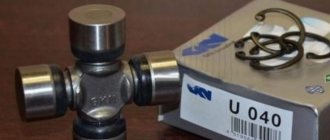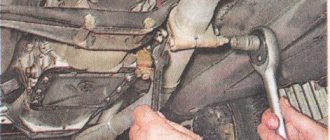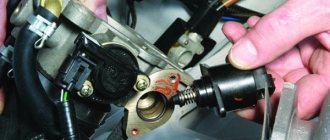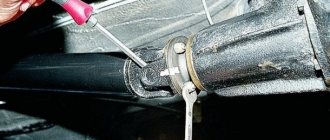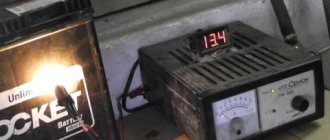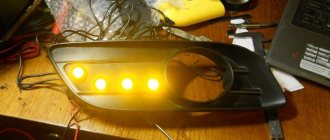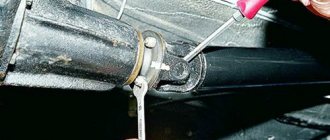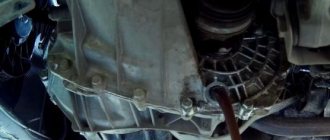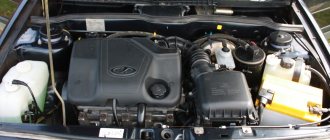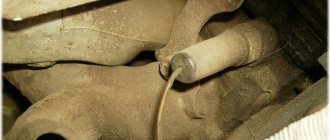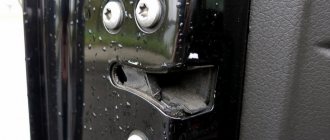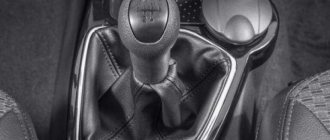How to inject cardan crosspieces? Just something complicated
Quite often, drivers wonder how to inject cardan crosspieces.
This is one of the common questions that beginners ask, but this work needs to be done quite often. At the same time, injecting is not a complicated action; it can be done in any garage, but you will need a tool. And despite the ease of repair, many people are simply afraid to touch the driveshaft themselves; for some reason it is believed that any work with the transmission requires high qualifications. This approach is justified if it is necessary to overhaul the automatic transmission, but the lubrication of the crosspieces can be done independently. How to inject cardan crosspieces is a simple question. To do this, there are a number of devices that make the task easier. It is much more difficult to correctly determine the time when this needs to be done. Here the task is complicated by the need to determine whether the crosspiece needs to be replaced completely, or whether it is enough to simply lubricate it. Below we will look at all these points.
How to remove the cross
In order to carry out the removal, you need to prepare a standard set of keys, then we perform the following series of actions:
- We drive vehicles onto an overpass or inspection hole
- We take a 13mm wrench and unscrew the bolts that secure the cardan, we do this with one wrench, since the bolts will not turn. During the turning process, you must try to avoid resting the nut on the transfer case and mud rings, since if the spline comes off or deformation occurs, a metallic clinking sound will appear while driving.
- When the cardan is removed, it should be syringed, after first cleaning it from dirt with a grease fitting. You should spray until new lubricant comes out from everywhere.
- To put the cardan in place, put it in a vertical position and press a little, this must be done so that the excess comes out of the spline joint, and the internal pressure subsides, and it will be difficult to put it back in place.
In order to lubricate the crosspiece bearings, it is enough to remove the protective cap from the grease nipple and pump grease with a syringe, lubricate until grease begins to come out of all four bearings.
Therefore, it is necessary to do this procedure, otherwise the cross will fail and you will have to buy a new one, and this is quite a costly affair.
Design features
The driveshaft consists of 2 elements (in some types of equipment there are 3 elements), this allows you to transfer force from the gearbox to the axle with minimal losses. The elements are connected to each other by a cross. This hinge connection allows for optimally secure fastening between the nodes. At the same time, minimal wear of the associated elements is ensured.
The crosspiece requires constant lubrication
, so it is tightly stuffed with a plastic substance at the factory. This allows you to avoid problems during operation. But, unfortunately, there is not enough lubricant for the entire service life, so it must be added.
For process continuity, manufacturers have provided the ability to supply lubricant directly inside the crosspiece, without dismantling the cardan. This makes operational work easier. Also, thanks to this, it is possible to quickly perform injection if necessary.
If you do not lubricate the part, it will fail much faster. It is also worth considering that the crosspiece is almost constantly exposed to sand, dirt and reagents. Therefore, only the proper amount of lubrication can avoid many problems with this structural element.
How to syringe crosses in the field
Let's start today's conversation with a brief excursion into technical literacy.
What is a spider and why a driveshaft?
Every driver generally understands that a driveshaft is a kind of tool that transmits force from the transfer case to the gearbox, and then to the wheels of the car.
For the first time, this principle of energy transfer was described by the Italian mathematician J. Cardano, in whose honor it was later named, was first used in mechanical engineering at the end of the 19th century by Louis Renault and has remained an indispensable element for all-wheel drive and rear-wheel drive cars for more than a century.
The driveshaft consists of a tube-shaped shaft with forks at the ends and two crosspieces.
The crosspiece is a part of the driveshaft that allows for flexible connection of the transfer case and vehicle axles.
The crosspiece is located between two rigidly fixed forks of the propeller shaft and is driven by a system of needle bearings located at the four ends of the crosspiece.
(I’m thinking of inserting a gif with a gimbal from the Internet. It’s hard for the user to perceive in my opinion)
Cross bearings, an element that is in constant extreme conditions. Water, sand, dirt wash out the lubricant, which in the absence of maintenance leads to failure of the crosspiece.
The photo shows that all the needles have fallen out of the bearing and instead of lubricant there is only dirt and ground metal.
How to recognize the imminent “death” of a crosspiece?
1. Starting from a standstill will be accompanied by a characteristic impact with a metallic sound 2. The car will begin to vibrate at speed 3. Before completely falling apart, a characteristic crunch of ground iron will be heard
However, the death of crosspieces can be prevented and their replacement can be delayed indefinitely.
To do this, it is necessary to carry out periodic technical inspection of the transmission, inject the crosspieces at approximately the same time as changing the engine oil, i.e. every five to six thousand kilometers.
Today we will tell you in detail how to carry out injecting yourself, and not give money to services for a service that they can ultimately “provide” to you.
— For highly loaded components and assemblies. — Effective universal grease for automotive, industrial and agricultural work. — Has excellent water-repellent and anti-corrosion properties. Suitable for use on boats, ships and yachts. — Ideal for lubricating bearings, ball joints, water pumps, steering rods, suspension parts, moving and sliding mechanisms operating in difficult conditions and outdoors.
Used for cleaning the surface of engines, spare parts, and industrial equipment. Effectively removes oily stains, bitumen, resin and other contaminants.
When is work required?
It is important to correctly determine when to add lubricant, this will significantly increase the life of the spider. According to the manufacturers' recommendations, this element should be lubricated about once every 10-15 thousand kilometers; more precisely, you need to look at the list of scheduled maintenance work.
But it is not always the case that crosspieces can be used freely for the entire time allotted for this by the manufacturer without lubrication. The reasons for this are very different, most often due to rather harsh operating conditions. Often, SUVs that are operated in harsh conditions require increased attention to the driveshaft. This is due to constant contamination of the joint, which leads to the production of lubricant at an accelerated rate.
In any of the above cases, it is simply necessary to eliminate the problem as soon as possible.
How often should lubrication be carried out?
Manufacturers regulate the frequency of injecting crosses in the operating instructions. You can also contact an authorized service center, where specialists can check the condition of the transmission and recommend lubrication and frequency of maintenance of the driveshaft.
It is generally accepted that the life cycle of a driveshaft spider is about 500,000 km. And this is only if you comply with the care and maintenance requirements, including changing the lubricant. Depending on the nature of driving, terrain and operating conditions, the lubricant must be changed every 10-20 thousand kilometers. Most experts recommend doing this at a service center during maintenance.
However, there are a number of signs when it is necessary to lubricate the driveshaft crosspieces as soon as possible. Here are the main ones:
- When the crosspiece begins to crunch for no apparent reason.
- The crosspiece vibrates strongly, especially when accelerating to speeds above 50 km/h or when starting the car from a standstill.
- Noise, whistling or grinding, as well as hum or clicks coming from the crosspiece.
If you notice one or more of the following symptoms in your vehicle, be sure to contact a mechanic or have your driveshaft joints lubricated as soon as possible.
Necessary tool
So, you have established that it is necessary to lubricate the cardan cross once again. It is worth considering that this work cannot be done without a special tool, so you will have to prepare for the process in advance.
First of all, purchase a special syringe for lubricating cardan shafts; it is inexpensive and will last quite a long time. For this work, a lever-plunger type syringe is used. Please note that different models have different holes for lubricant supply, oil seals or nipples may be used, so check this nuance and purchase the appropriate nozzle.
Another point is the choice of lubricant
. Here it is worth familiarizing yourself with the manufacturer's recommendations. In many cases, modern cars use a specialized lubricant that is designed for a specific brand. The result of mixing it with other types of lubricant is quite difficult to predict. Therefore, if the manufacturer accurately indicated a specific brand of grease, it is better to use that particular one. If there are no clarifications on this matter, then you can use any option designed for such an application.
Consequences of ignoring a fault
Ignoring the lubrication of crosspieces can lead to the most disastrous consequences, including complete failure of the spare part and breakdown of your car. In this case, you risk not only your life, but also the lives of passengers.
If you do not carry out the procedure, you risk facing the following consequences:
- Vehicle vibrations: Worn seals or bushings can cause the driveshaft to vibrate. Failure to properly lubricate spiders, joints, or bushings can cause further damage to other transmission components. Note that tire problems can also cause vibration problems, but they are easy to tell apart. Vibrations caused by tire balance problems are speed sensitive, but driveshaft vibrations are not.
- Difficulty turning: If you are having trouble turning, it may be caused by a problem with the driveshaft. A faulty driveshaft can prevent your wheels from turning correctly, making your vehicle difficult to control.
- Loud noise: If you hear a loud noise when your car shifts gears, this is another sign of damage to the driveshaft. The likely culprit is worn crosspieces.
- Car shudders when accelerating. If you feel a shudder when accelerating from a standstill or at low speeds, a loose weld or a bad center bearing may be to blame.
- Squeaking noise: An annoying squeaking noise at low speeds can be caused by a lack of lubrication on the spiders. The lubrication procedure will get rid of it.
- A clicking or knocking noise may indicate a worn or faulty driveshaft. Contact your mechanic.
As you can see, in order to ensure long-term and stable operation of your car, in addition to standard maintenance, you must carefully monitor the lubrication of the cardan crosspieces.
How to inject?
Let's look at the process of doing this work. It is worth noting that on almost all models it is completely the same, there are only minor differences. So, lubrication is carried out in the following order:
- Drive the car onto the overpass. Wheel chocks are placed under the wheels;
- Clean the cross. To do this, first wipe it with a rag, then wash it with diesel fuel or carburetor cleaner;
- Prepare the syringe for use by pumping the required amount of lubricant into it;
- They open access to the slots of the crosspiece, and use a syringe to pump the part with lubricant through an oiler. Be sure to open the oiler on both sides; pump until new lubricant comes out from the other side; it will be noticeably different in color.
At this point the work can be considered completed.
conclusions
. As you can see, there is nothing complicated here. To answer the question of how to inject cardan crosspieces, it is enough to know the technical features of this car unit. In general, neither the selection of tools nor the work process itself should cause any difficulties. It is worth considering that the service life of the crosspieces and cardan directly depends on the quality of the lubricant. Therefore, do not neglect this work.
What is used for lubrication
Tool kit for lubricating the universal joint
The set of tools and tools used for the procedure of lubrication of the crosspiece/crosspieces depends on the method of its implementation. There are two of them - with and without dismantling the driveshaft. It is worth mentioning that the first method, although more labor-intensive, allows you to achieve a better result, since with its help you can visually control not only the amount of lubricant, but also the method of its placement, the quality of filling the lubricated cavity. Lubrication without dismantling is much simpler, but even with it there is a risk that the lubricant will not spread completely throughout the volume, and therefore the quality of lubrication will remain in question. Lubrication of the cross must be done by first driving the car into an inspection hole or lifting it on a lift (more suitable for a service station or car service center).
So, in order to lubricate the cross without dismantling the driveshaft you will need:
- directly lubricant for the crosspiece;
- a lever syringe with a lubricant where the lubricant is placed;
- adapter for a syringe (optional, used if the oiler is in an inconvenient place for refilling it).
If you nevertheless decide to dismantle the driveshaft from the car, then in addition to the means listed above, you will also need additional plumbing tools, with the help of which, in fact, you will need to perform the dismantling. Usually these are wrenches, screwdrivers, and sometimes a hammer. The procedure for dismantling the driveshaft will differ for different car models, but remember that the driveshaft is a fairly heavy part, so when dismantling it, you must follow safety rules!
Remember that the procedure for dismantling the driveshaft involves contact with dirty surfaces and simply dirt (grease). Therefore, it is advisable to have rags on hand, and it is better to work with gloves. After work, you can use special hand cleaners.
Different machines have different locations of grease nipples on the crosspieces. This needs to be clarified further in the technical documentation. Filling the bearing with oil must be carried out until old grease flows from under the seals or from the opposite hole of the oiler (usually it differs in consistency, composition and color). In the future, the old lubricant must be removed from the surface of the transmission parts.
If the crosspiece is very dirty, it is better to clean it using special cleaning products or other similar cleaners. This will be a good preventive measure to ensure that dirt from the external surfaces of the parts does not get inside the bearings.
Injection of the cardan shaft crosspiece
Grouting the driveshaft spider is a fairly simple job that must be performed regularly to maintain the transmission in working condition. However, many drivers decide to seek such work at a service station, when it is quite possible to do it themselves. The main thing that is required to perform this kind of work is to have the necessary tools and choose the right way to inject the cardan crosspieces with it. In this article we will consider this issue.
UAZ hunter and 469
Modern lubricants are characterized by high performance characteristics and versatility. And if for older cars the use of strictly defined types of lubricant was strictly regulated, now this is much easier. But there are still basic lubricants whose characteristics are most suitable for certain components, including for lubrication of cardan shaft crosspieces.
The listed types are designed specifically for needle bearings and are made on a lithium base with the addition of antioxidant and anti-wear additives, which significantly increase the lubricant change period in friction units. FIOL additionally contains 5% molybdenum disulfide, which increases mechanical properties.
Grease No. 158 is easily distinguished by its intense blue color, which is the result of the introduction of copper phthalocyanine into the composition. Disadvantages include the ability to stain hands and clothing, as well as irritation that can occur on the skin as a result of prolonged exposure.
Design features
The driveshaft consists of 2 elements (in some types of equipment there are 3 elements), this allows you to transfer force from the gearbox to the axle with minimal losses. The elements are connected to each other by a cross. This hinge connection allows for optimally secure fastening between the nodes. At the same time, minimal wear of the associated elements is ensured.
The crosspiece requires constant lubrication, so it is tightly packed with a plastic substance at the factory. This allows you to avoid problems during operation. But, unfortunately, there is not enough lubricant for the entire service life, so it must be added.
For process continuity, manufacturers have provided the ability to supply lubricant directly inside the crosspiece, without dismantling the cardan. This makes operational work easier. Also, thanks to this, it is possible to quickly perform injection if necessary.
If you do not lubricate the part, it will fail much faster. It is also worth considering that the crosspiece is almost constantly exposed to sand, dirt and reagents. Therefore, only the proper amount of lubrication can avoid many problems with this structural element.
When is work required?
It is important to correctly determine when to add lubricant, this will significantly increase the life of the spider. According to the manufacturers' recommendations, this element should be lubricated about once every 10-15 thousand kilometers; more precisely, you need to look at the list of scheduled maintenance work.
But it is not always the case that crosspieces can be used freely for the entire time allotted for this by the manufacturer without lubrication. The reasons for this are very different, most often due to rather harsh operating conditions. Often, SUVs that are operated in harsh conditions require increased attention to the driveshaft. This is due to constant contamination of the joint, which leads to the production of lubricant at an accelerated rate.
As a rule, experienced mechanics recommend not waiting for the time specified by the manufacturer, but adding grease at the first sign of a problem.
The following symptoms usually indicate the need for this work:
- When starting off, a characteristic noise is heard in the area of the cardan, usually a crunching or tapping sound;
- There is vibration when moving. Moreover, it starts to vibrate only at a speed of 60-80 km/h; a lot depends on the car model.
In any of the above cases, it is simply necessary to eliminate the problem as soon as possible.
What is a cardan shaft
The job of the driveshaft is to transfer force from the vehicle's gearbox to the axle. Most often it consists of two or three elements interconnected by a cross. The crosspiece is a hinge joint that provides reliable fastening between units with minimal wear during operation of the mating elements.
In order for the crosspiece to fully cope with its functions and not lose efficiency, it needs constant lubrication. When the car leaves the factory, the crosspiece is tightly packed with lubricant, which should be enough for a long time of operation of the mechanism, but at a certain time it runs out and needs to be replenished.
Lubricant for driveshaft crosspieces - what to lubricate with and which lubricant is better (TOP 7)
Lubricating the crosspiece ensures the normal operation of its bearings and also increases their service life. It must have the ability to be used in highly loaded mechanisms, as well as water-repellent and anti-corrosion properties. Currently, there are various versions of such lubricants on the market - from the Liqui Moly company, the grease for universal joints “158”, which has been popular since Soviet times, a product from Mobil and others. The choice should be based on their performance, availability and price.
When to inject a universal joint on a driveshaft
The list of scheduled vehicle maintenance work should indicate the frequency of injection of the driveshaft crosspiece as recommended by the vehicle manufacturer. On average, the lubricant component must be updated every 10-15 thousand kilometers of the vehicle.
Important: When operating a vehicle in difficult conditions, the service life of 10-15 thousand kilometers is significantly reduced. For example, if we are talking about constant off-road driving, you need to take care of lubricating the crosspiece much more often.
There are several symptoms that indicate that the driveshaft crosspiece needs to be injected:
- When the car moves from a standstill, a noise similar to crunching or tapping is heard in the area of the driveshaft;
- At high speeds (above 60 kilometers per hour), the vibration of the car and the “shaking” of the cardan are clearly noticeable.
If the above symptoms are observed on the car, you need to inject the driveshaft crosspiece as soon as possible.
What kind of lubricant should be used for crosspieces?
Manufacturers of oils and lubricants sell a fairly large assortment of materials intended directly for both universal joints and having general positive characteristics for various parts of a car or other equipment. To make the best choice, you need to pay attention not only to the cost of the lubricant and the manufacturer, but also to its main performance characteristics. You can get all the necessary information from your car's owner's manual or from your mechanic.
If we talk directly about the cardan, then a suitable mixture for it should have the following properties:
- high anti-corrosion and water-repellent properties;
- the lubricant must be designed for use over a wide range of temperatures and pressures (resistance to high temperature and pressure is required);
- should be thick and sticky; this way it can remain in place even with high vibration or intense rotation of parts;
- must be safe for human health;
- mineral lithium compounds are used to lubricate components and parts of the suspension and transmission, so the lubricant for the cross must be combined with them;
- the characteristics of the composition should extend the service life of the driveshaft components, increasing the range of its replacement;
- the density of the composition should not increase with decreasing temperature;
In a word, the mixture must have high mechanical and chemical properties, maintain density and composition under different extrusion conditions, and also withstand the effects of external aggressive factors.
How to inject the cardan shaft crosspiece
To carry out the work of injecting the cardan crosspiece, you will need to purchase a special tool - a syringe for lubricating cardan shafts. It can be purchased at almost any specialized automotive store. Such a syringe has a lever-plunger design and can last for many years.
Please note: Depending on the car model, the technological hole through which the lubricant is “poured” differs. Before purchasing a syringe, you need to determine whether seals or nipples are used, since you will need the appropriate nozzle.
You need to choose the lubricant that will be used for injection based on the recommendations of the car manufacturer. Most often, a lubricant specialized for a specific car model is used, and it is better to purchase it. If you pump a lubricant into the crosspiece that is different from what is already present there, there is a high risk of their “incompatibility,” which can lead to various kinds of problems.
Please note: If the vehicle's technical operating instructions do not indicate which specific lubricant to use for injecting the driveshaft crosspiece, this means that any universal grease will do.
What lubricant should I use for crosspieces?
Since the crosspiece of a car is one of the key parts that need lubrication, you should not skimp on materials. It is necessary to select compounds that have high performance characteristics and are able to cope with the high loads to which this part is subjected.
Mandatory lubrication requirements for propeller shaft crosspieces are:
- 1. Water resistance.
It is possible that moisture can get inside, and the lubricant must adhere well to the part so as not to wash out. - 2. Corrosion protection
. Lubricant protects parts from rust. - 3. Operability in a wide temperature range
. The equipment is used both in winter and summer. In addition, the driveshaft itself is subject to high pressure. The lubricant must withstand difficult operating conditions. - 4. Good adhesion to the surface
. You cannot pour oil into the cardan: it will drain from the parts, as a result they will be subject to scuffing and quickly fail. The lubricant for crosspieces must be gel-like and have high colloidal stability, so that even after softening it can restore the structural frame again. - 5. Chemical stability
. The lubricant must not react with alkalis, acids, solvents and other chemicals. - 6. Compatibility with other lubricants
. If before or after lubrication of the crosspiece other compounds were placed in the transmission units, then the universal joint lubricant must be compatible with them.
Lubricant for crosspieces of UAZ and cars of other brands must be operable in the temperature range from -50 to +100 ° C, be water resistant, and have anti-corrosion and extreme pressure additives. "MSK" offers to buy products that are ideal in all respects.
How to inject a universal joint on a cardan shaft
To carry out the work of injecting the driveshaft crosspiece, you will need to drive the car onto an overpass and install wheel chocks under the wheels. Next, follow these steps:
- Remove dirt from the crosspiece. It is recommended to use carburetor cleaner, special cleaning compounds, or simply white spirit for this;
- Next, pump the purchased lubricant into the syringe;
- Open access to the slots of the crosspiece and, using the prepared syringe with grease, pour grease into the part through the “oiler”.
Important: When pumping lubricant, open the oil can on both sides. It is necessary to pump in lubricant from one side until grease begins to come out from the other side, then we can assume that it is completely filled with lubricant. Please note that the grease coming out from the other side will be different in color.
After completing the steps described above, you can consider the work completed.
How and when to inject the driveshaft crosspiece: instructions
Grouting the driveshaft spider is a fairly simple job that must be performed regularly to maintain the transmission in working condition. However, many drivers decide to seek such work at a service station, when it is quite possible to do it themselves. The main thing that is required to perform this kind of work is to have the necessary tools and choose the right way to inject the cardan crosspieces with it. In this article we will consider this issue.
1. What is a cardan shaft 2. When to inject a cardan shaft crosspiece 3. How to inject a cardan shaft crosspiece 4. How to inject a cardan shaft crosspiece
The job of the driveshaft is to transfer force from the vehicle's gearbox to the axle. Most often it consists of two or three elements interconnected by a cross. The crosspiece is a hinge joint that provides reliable fastening between units with minimal wear during operation of the mating elements.
In order for the crosspiece to fully cope with its functions and not lose efficiency, it needs constant lubrication. When the car leaves the factory, the crosspiece is tightly packed with lubricant, which should be enough for a long time of operation of the mechanism, but at a certain time it runs out and needs to be replenished.
Adding lubricant to the crosspiece is quite simple, and this can be done without removing the driveshaft through the technological hole. Depending on the car model, its location may differ.
Important: The driveshaft crosspiece is almost always exposed to sand, dirt and other harmful factors. If it is operated in such conditions without lubrication, it will quickly become unusable, so it is necessary to correct the situation immediately after identifying the problem of lack or a small amount of lubrication.
When to inject a universal joint on a driveshaft
The list of scheduled vehicle maintenance work should indicate the frequency of injection of the driveshaft crosspiece as recommended by the vehicle manufacturer. On average, the lubricant component must be updated every 10-15 thousand kilometers of the vehicle.
Important: When operating a vehicle in difficult conditions, the service life of 10-15 thousand kilometers is significantly reduced. For example, if we are talking about constant off-road driving, you need to take care of lubricating the crosspiece much more often.
There are several symptoms that indicate that the driveshaft crosspiece needs to be injected:
- When the car moves from a standstill, a noise similar to crunching or tapping is heard in the area of the driveshaft;
- At high speeds (above 60 kilometers per hour), the vibration of the car and the “shaking” of the cardan are clearly noticeable.
If the above symptoms are observed on the car, you need to inject the driveshaft crosspiece as soon as possible.
How to inject the cardan shaft crosspiece
To carry out the work of injecting the cardan crosspiece, you will need to purchase a special tool - a syringe for lubricating cardan shafts. It can be purchased at almost any specialized automotive store. Such a syringe has a lever-plunger design and can last for many years.
Please note: Depending on the car model, the technological hole through which the lubricant is “poured” differs. Before purchasing a syringe, you need to determine whether seals or nipples are used, since you will need the appropriate nozzle.
You need to choose the lubricant that will be used for injection based on the recommendations of the car manufacturer. Most often, a lubricant specialized for a specific car model is used, and it is better to purchase it. If you pump a lubricant into the crosspiece that is different from what is already present there, there is a high risk of their “incompatibility,” which can lead to various kinds of problems.
Please note: If the vehicle's technical operating instructions do not indicate which specific lubricant to use for injecting the driveshaft crosspiece, this means that any universal grease will do.
How to inject a universal joint on a cardan shaft
To carry out the work of injecting the driveshaft crosspiece, you will need to drive the car onto an overpass and install wheel chocks under the wheels. Next, follow these steps:
- Remove dirt from the crosspiece. It is recommended to use carburetor cleaner, special cleaning compounds, or simply white spirit for this;
- Next, pump the purchased lubricant into the syringe;
- Open access to the slots of the crosspiece and, using the prepared syringe with grease, pour grease into the part through the “oiler”.
Important: When pumping lubricant, open the oil can on both sides. It is necessary to pump in lubricant from one side until grease begins to come out from the other side, then we can assume that it is completely filled with lubricant. Please note that the grease coming out from the other side will be different in color.
After completing the steps described above, you can consider the work completed.
( 226 votes, 4.46 out of 5) Loading...
Source: https://okeydrive.ru/shpricevanie-krestoviny-kardannogo-vala/
Technical issues of various series
Those. Landcruiser series 40, 55, 60 questions
Classic axle spring Landcruiser 4x, 55 and 6x series
Those. questions Landcruiser "light" 7x (2L, 2L-T(E), 3L, 1KZ-T(E) and 22R(E))
Easy 70s and everything about them
Those. questions Landcruiser "heavy" 7x (1HZ, 1PZ, 3B, 1FZ-FE)
Expeditionary Classics (75-79 Pickup)
Those. questions Landcruiser 80, 100, 105 series (Lexus LX 450, 470)
Questions about full-size and axle SUVs
Those. Landcruiser 200 (Lexus LX 570), Sequoia, Tacoma, Tundra questions
Modern Toyota developments in the field of large SUVs and pickups
Those. 4Runner and HiLux 1st and 2nd generation questions
SUVs and pickups of the 6x and 130 series
Those. questions 4Runner and HiLux 3rd generation, Landсruiser Prado 9x
Cars series 185 and Prado series 9x
Those. 4Runner and HiLux 4th and 5th generation questions; Landсruiser Prado 12x,150 (Lexus GX); FJ Cruiser
Platform machines 215 and 285
Those. questions Highlander (Lexus RX), RAV4 and other Toyota cars
Discussion of all four-wheel drive Toyotas
How to properly lubricate driveshaft crosspieces
From trucks and SUVs to compact cars and sedans, your vehicle's powertrain system helps keep you on the road.
Also called the driveshaft, the transmission is responsible for shifting your vehicle from idling to driving. A bad or faulty driveshaft can make your vehicle difficult to control. And the main cause of breakdowns is the lack of lubricating mixture in its connections.
Lubrication procedure
Let's look at the correct procedure for lubricating the crosspieces without removing the shaft.
- Clean the crosspieces. These shaft parts are in a very aggressive environment, so they are likely to become very dirty. For a thorough cleaning, it is best to use engine or carburetor cleaner. At the end of the procedure, wipe the crosses dry.
- Prepare materials for lubrication. After cleaning the crosspieces, prepare lubricants. To do this, unscrew the cap from the syringe and the plastic cover from the lubricant cartridge. An iron cap will appear under the latter.
- Assemble the syringe. Place the syringe in the hole in the cartridge and unscrew the iron cap.
- The process of pumping lubricant. Place one end of the syringe into the hole in the cleaned oil can and begin pumping lubricant. At the same time, make sure that the syringe handle is squeezed all the way. This will ensure full penetration of the lubricant into it.
- Lubricate all points of the part. The shaft has 3 such points in total. Two of them are on the crosspieces, and another one is on the spline joint.
Old grease will begin to come out from the opposite side of the crosspieces. Continue the procedure until fresh appears from there. You can distinguish it from the old one by color and density (the new grease will be red). That's all!
Consequences of ignoring a fault
Ignoring the lubrication of crosspieces can lead to the most disastrous consequences, including complete failure of the spare part and breakdown of your car. In this case, you risk not only your life, but also the lives of passengers.
If you do not carry out the procedure, you risk facing the following consequences:
Vehicle vibrations: Worn seals or bushings can cause the driveshaft to vibrate. Failure to properly lubricate spiders, joints, or bushings may result in further damage to other transmission components.
Note that tire problems can also cause vibration problems, but they are easy to tell apart. Vibrations caused by tire balance problems are speed sensitive, but driveshaft vibrations are not. Difficulty turning. If you have trouble turning, it may be caused by a problem with the driveshaft.
A faulty driveshaft can prevent your wheels from turning correctly, making your vehicle difficult to control. Loud noise: If you hear a loud noise when your car shifts gears, this is another sign of damage to the driveshaft. The likely culprit is worn crosspieces. Car shudders when accelerating. If you feel a shudder when accelerating from a standstill or at low speeds, a loose weld or a bad center bearing may be to blame. Squeaking noise: An annoying squeaking noise at low speeds can be caused by a lack of lubrication on the spiders. The lubrication procedure will get rid of it. A clicking or knocking noise may indicate a worn or faulty driveshaft. Contact your mechanic.
General technical questions
Issues of operation and maintenance of automatic transmissions on Toyotas and not only. Because the boxes of many models overlap
Tuning, styling, interior, car audio and theft protection
“Non-power” body kit, trim and restoration of the interior, car audio, sound insulation, anti-theft, etc. for all models of Toyota SUVs.
Other related Toyota issues.
Life of Toyota 4x4 - problems and solutions are common to all platforms.
Technical non-Toyota questions
Any car from Acur to UAZ, if it has a steering wheel, wheels and it’s not a Toyota
Who injects balls and crosses with what?
According to Castrol:
I confess, I was wrong when I said that Castrol LM lubricant is better than Litol-24 lubricant in the operating temperature range. I downloaded the original Specifications for these two lubricants (Castrol LM and LMX) from the German Castrol website, where they are produced. The old habit of working only with original documents worked.
So, Specification for Castrol LM lubricant, document number DCV: GY-LMMEHZ-, date 02/27/2002/JH/05, i.e. last revised in 2005
What is the difference between the original and the translation?
1). The original does not comply with the Specifications/Approvals MAN 283 “Li-P” and MB 267 present in the translation.
2). The original indicates the type of thickener is lithium-calcium soap, and the translation indicates lithium soap.
3). The operating temperature range in the original is from – 35 to +120 °C. Translated by the Specifications, from – 35 to +140 °C.
As we can see, the lubricant has been significantly improved in the process of translating the Specification from German into Russian. However, the translation contains the following disclaimer: “The data provided are for reference only, do not represent technical specifications for the product and cannot be considered as a strict factory standard. The information contained is subject to change without notice and is current at the time of publication.”
It must be assumed that this relieves the Castrol dealership of any and all liability after the consumer uses their lubricants. But another question arises: “Where then does Castrol in Russia and other CIS countries have the technical conditions for lubrication that any consumer needs?”
4). Third difference. The original LM grease is classified according to DIN 51502 as KP 2 K-30. What does it mean: “Grease (2), intended for lubrication of sliding and rolling bearings (K), containing anti-wear additives (P), produced on the basis of mineral oil. Maximum application temperature +120 °C (K). The lower limit of the temperature range for use is minus 30 °C (-30).
In translation, LM grease according to the DIN 51502 standard is designated as KTA PL 2 N. What the TA PL designations mean is unknown to the DIN 51502 standard! And the letter N means the maximum temperature of use is + 140 °C.
5). Screw him with all this. Let this all be on the conscience of the people from Castrol, if there is one, of course, and this category is intangible. The most amazing and amazing thing is not this. The Russian translation of the LM Grease Specification indicates the AMERICAN standard ASTM D-2509 (Timken OK Load, lb. - Timken OK load, kg.), which they sound like “Timken test of extreme pressure properties ultimate load, lbf.” The translation of the name of the standard is incorrect, but that is not important. This standard is NATURALLY absent from the German original, because it is equivalent to the fact that tomorrow the entire Arab world will start eating pork or the entire population of Europe will convert to Islam!
This moment attracted my attention first of all when I became closely acquainted with the translation and aroused reasonable suspicions.
Let's finish this topic.
Operating temperatures of Litol-24 lubricant according to GOST 21150-87 are from minus 40 to +120 °C; it remains operational for a short time at a temperature of +130 °C. So in these parameters, Litol-24 is superior to Castrol LM lubricant.
Operating temperatures of Castrol LMX lubricant according to German Specifications are from minus 30 to +150 °C, and not from minus 35 to +170 °C. So this lubricant does NOT correspond to the Average Quality Category of NLGI GB automotive lubricants, as I wrote earlier, based on an unreliable translation. It exactly corresponds to the LOWER Quality Category NLGI GA, just like Castrol LM lubricant.
Let me remind you that NLGI GA greases are used to lubricate wheel bearings of cars, trucks and other vehicles operating in light duty with frequent grease changes under normal operating conditions.
Taken from here https://www.huskey.com.ua/phorum/viewtopic.php
Common topics
Meetings, rides and events of the Land-Cruiser.ru club
Trips, meetings, events, competitions organized by the site Land-Cruiser.ru
Events of other clubs
Announcements about events of other clubs
Congratulations, funny jokes and other offtopic
Auto tourism
Trips. Cards. Tracks reports.
We sell, buy, exchange.
Car sale
Please place advertisements for car sales here
Store Market.land-cruiser.ru
General questions about store operations and product discussions
General questions about store operations and product discussions
RAF Trophy Raid Committee
News, announcements and communication with representatives of the RAF Trophy Raid Committee
Technical and organizational issues
Everything related to specific competitions: where they are held, who is going, what helmet to buy, how to connect the trip, etc.
Flea market (motorsport)
Purchase and sale of auto sports equipment
How and why to syringe the driveshaft crosspieces? blog and news
Let's start today's conversation with a brief excursion into technical literacy.
What is a spider and why a driveshaft?
Every driver generally understands that a driveshaft is a kind of tool that transmits force from the transfer case to the gearbox, and then to the wheels of the car.
For the first time, this principle of energy transfer was described by the Italian mathematician J. Cardano, in whose honor it was later named, was first used in mechanical engineering at the end of the 19th century by Louis Renault and has remained an indispensable element for all-wheel drive and rear-wheel drive cars for more than a century.
The driveshaft consists of a tube-shaped shaft with forks at the ends and two crosspieces.
The crosspiece is a part of the driveshaft that allows for flexible connection of the transfer case and vehicle axles.
The crosspiece is located between two rigidly fixed forks of the propeller shaft and is driven by a system of needle bearings located at the four ends of the crosspiece.
(I’m thinking of inserting a gif with a gimbal from the Internet. It’s hard for the user to perceive in my opinion)
Cross bearings, an element that is in constant extreme conditions. Water, sand, dirt wash out the lubricant, which in the absence of maintenance leads to failure of the crosspiece.
The photo shows that all the needles have fallen out of the bearing and instead of lubricant there is only dirt and ground metal.
How to recognize the imminent “death” of a crosspiece?
1. Starting from a standstill will be accompanied by a characteristic impact with a metallic sound 2. The car will begin to vibrate at speed 3. Before completely falling apart, a characteristic crunch of ground iron will be heard
However, the death of crosspieces can be prevented and their replacement can be delayed indefinitely.
To do this, it is necessary to carry out periodic technical inspection of the transmission, inject the crosspieces at approximately the same time as changing the engine oil, i.e. every five to six thousand kilometers.
Today we will tell you in detail how to carry out injecting yourself, and not give money to services for a service that they can ultimately “provide” to you.
— For highly loaded components and assemblies. — Effective universal grease for automotive, industrial and agricultural work. — Has excellent water-repellent and anti-corrosion properties. Suitable for use on boats, ships and yachts. — Ideal for lubricating bearings, ball joints, water pumps, steering rods, suspension parts, moving and sliding mechanisms operating in difficult conditions and outdoors.
Used for cleaning the surface of engines, spare parts, and industrial equipment. Effectively removes oily stains, bitumen, resin and other contaminants.
3. Grease syringe. Lever-plunger
All injection work can be easily done without removing the units, on any lift or pit. In our case, it was necessary to simultaneously change one of the crosspieces, so the operation is carried out on the removed cardan shaft.
As we said above, crosspieces are in an extremely aggressive environment, so they often look like in the photo. Before starting work, clean the surface with carburetor cleaner, you can also use a professional engine cleaner
For injection we will need a grease syringe - lever plunger or pneumatic, it all depends on the budget, as well as a lithium grease cartridge.
After unscrewing the cap, remove the plastic cap from the cartridge and load it inside the syringe.
After charging, open the top iron cover and screw it back on.
Connect the syringe to the grease nipple and pump. The guarantee that you are doing everything correctly will be the old grease that begins to come out of the cross.
We squeeze out all the old grease from the crosspiece bearings, along with dirt and wear, until red grease comes out.
Now the driveshaft can be installed in place!
Injection of other transmission elements.
Do not forget that in addition to crosspieces, there are other parts that need to be serviced. 1. Splined cardan shaft. On the shaft pipe you can see a grease nipple; it serves to lubricate the spline connection of the two parts of the cardan. It should be injected together with the crosspieces.
Steering tips. Good manufacturers of spare parts always have grease fittings on the steering ends. Periodic lubrication of balls will extend their service for many years.
Steering linkage. By analogy with the tip, it requires lubrication.
That's all! Take care of the condition of your car and it will never get old :)
Lubrication procedure
Let's look at the correct procedure for lubricating the crosspieces without removing the shaft.
- Clean the crosspieces. These shaft parts are in a very aggressive environment, so they are likely to become very dirty. For a thorough cleaning, it is best to use engine or carburetor cleaner. At the end of the procedure, wipe the crosses dry.
- Prepare materials for lubrication. After cleaning the crosspieces, prepare lubricants. To do this, unscrew the cap from the syringe and the plastic cover from the lubricant cartridge. An iron cap will appear under the latter.
- Assemble the syringe. Place the syringe in the hole in the cartridge and unscrew the iron cap.
- The process of pumping lubricant. Place one end of the syringe into the hole in the cleaned oil can and begin pumping lubricant. At the same time, make sure that the syringe handle is squeezed all the way. This will ensure full penetration of the lubricant into it.
- Lubricate all points of the part. The shaft has 3 such points in total. Two of them are on the crosspieces, and another one is on the spline joint.
Old grease will begin to come out from the opposite side of the crosspieces. Continue the procedure until fresh appears from there. You can distinguish it from the old one by color and density (the new grease will be red). That's all!
